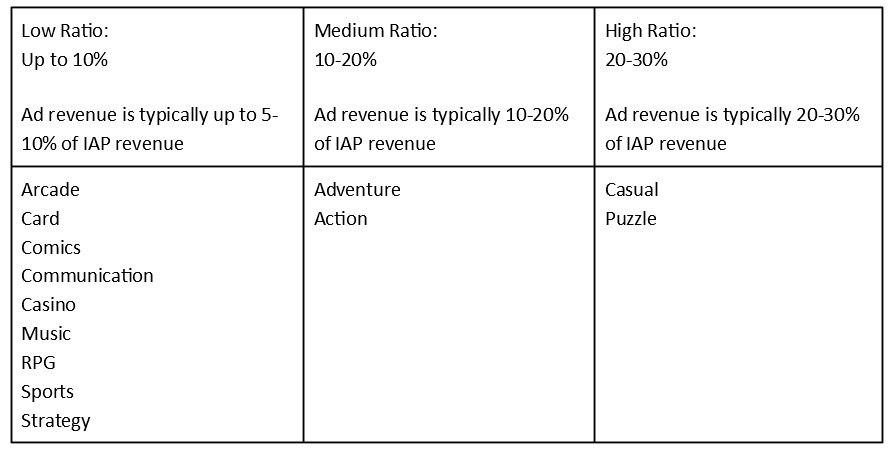How many games use in-app ads? How to estimate your game’s potential daily ad revenue? How to design ads into your game?
Orly Tsesis, Publisher Solutions Manager, CEE & Israel at Facebook Audience Network, explains how to transition your game to a hybrid monetization model and why now is the best time to do it.
Orly Tsesis, Publisher Solutions Manager, CEE & Israel at Facebook Audience Network
89% of top games worldwide had an ad platform SDK installed by the end of 2019. This is according to App Annie’s March 2020 report “Ad Monetization in Mobile Games: The Untapped Potential.”1 The world’s most successful gaming companies have been leading the charge and diversifying their revenue channels with in-app ads (IAA). Now — as the report demonstrates — they are seeing an uptick in other key performance metrics as well.
In-app ads have enabled these early adopters to earn more from their games. They have also had a positive impact on player engagement, user retention and user lifetime value (App Annie, 2020).
The data — aggregated from 1,000 top gaming apps — revealed that mobile game player retention holds steady after ad platform SDK installation (App Annie, March 2020).
And beyond retention, ad-monetized games are continuing to grow in downloads and monthly active users post-ad SDK installation.
In short, there couldn’t be a better time to start the transition to a hybrid monetization model. If you’re a publisher who still depends primarily on in-app purchase (IAP) earnings, we’ve pulled together a few practical strategies to help you make this transition.
Below, we’ll unpack a few genre and geographic highlights from the App Annie report to show why hybrid monetization is thriving. And then we’ll share the steps you can take to make hybrid monetization work for your game.
1Ad Monetization in Mobile Games: The Untapped Potential, App Annie (commissioned by Facebook Audience Network), March 2020 – a study of the global top 1,000 game apps, averaged across iOS and Google Play from January 1 through December 31, 2019.
There is untapped monetization potential for casual and core
For casual and core game developers who are considering diversifying their revenue model to include ads, the same report shared promising performance highlights:
In 2019, not only were casual games the most downloaded genre globally (82% share), but one-month post-ad SDK installation, average user sessions jumped almost 200% (App Annie, March 2020).
Core game developers should note that although this genre represented 76% of the time spent in top games in 2019, it only accounted for 7% of downloads (App Annie, March 2020). The high engagement of this market segment presents untapped potential for core developers to monetize with ads, if they can mobilize swiftly to take advantage.
Ads have doubled time spent in-app in Russia and other markets
Russian developers who are debating adding ads to their game revenue channels should note that — consistent with 2019 global performance trends — top Russian games saw time spent in-app nearly double between one month and three months post ad SDK-installation (App Annie, March 2020).
This region’s top genres are Casual Puzzle, Core RPG, and Core Action, based on time spent in the top 5 games with an SDK.
Where to start: Choose a game to test
Some publishers will test ads on a game after IAP revenue has peaked. Others choose to first test an app with a smaller player base. If you test ads on a game with a larger player base, you will have a greater potential revenue return.
Estimate your game’s potential daily ad revenue
To estimate the daily ad revenue potential of your game, use this equation as a guiding formula:
DAU x Ad Frequency per Day x Ad Engagement Rate/ 1,000 \1,000=SUBTOTAL x eCPM benchmarks = AD REVENUE POTENTIAL
One important thing to note: The right frequency of rewarded video ads can help players progress through the game without reducing the value of the reward. In past research2, we’ve found, among those surveyed, ~3.5 rewarded video ads per day per player to be a good starting point. Since engagement with the rewarded ad is user-initiated, this may mean offering ~10 ads/day to achieve the 3-3.5/day frequency target.
To double check the validity of your potential ad revenue estimation, you can compare it to industry average ranges of ad-to-IAP revenue. The ratio of ad revenue to IAP revenue differs by game genre, region and other factors; please use this guidance for popular genres only as an estimation.
2Facebook Internal Data from 534 apps in NA, EMEA, APAC, LATAM, April 2018, as published in Getting Started with In-App Ad Monetization Guide, February 2019.
Design the ad into your game
For this step, choose your ad’s entry point in the game. We recommend that you start with one of the most common rewarded video entry points, which are applicable to most game types:
- Out of lives: Offers an extra life for watching an ad.
- Boost reward: Awards pre- or mid-level progression boosts for watching an ad.
As a best practice, clearly state what the reward is and what the player needs to do to get the reward, so they are more likely to interact with the ad.
You can find more detailed tips in our online guide: 8 Common Rewarded Video Integrations.
Test ads on at least 10% of users
Next, set up an ad test with at least 10% of your game’s users. Some app stores allow you to easily run this test (e.g. Google Play).
If you prefer, you can set up your own A/B test using a 3rd party tool (e.g. Apptimize, AppsFlyer or Optimizely). Be sure to follow A/B testing best practices including:
- Keep other variables constant
- Run the test for at least 14 days.
Additional tips for A/B testing are offered in our online resource: Building for Better Revenue: How A/B Testing Can Help.
Review metrics, check churn and optimize
After your test has run for at least two weeks, look at your ARPDAU and compare it to your benchmarks. With rewarded video, occasionally a small percentage of your IAP users may migrate to become ad users; even in these cases, ARPDAU should be on an upward trend, signaling a positive impact on overall revenue.
If revenue uplift is not as much as you’d hoped, check whether the ad frequency is the same as in your calculated estimate. Adjust if needed and then re-test.
While churn from implementing ads is expected to be extremely low (e.g. 0.01%), you can check your churn rate to be sure there’s no significant loss of users.
At this point, we suggest you review and optimize the variables of your ad implementation.
- Receptiveness
- Creative
- Frequency
- Engagement
For guidance on how to optimize each of the below, consult our online toolkit: Building for Better Revenue.
Worldwide, real-life publishers are seeing incredible results
Looking for examples from real-life publishers? Casual gaming company Habby wanted to monetize with both in-app purchases and ads while adding value to the player experience.
After testing and launching Facebook Audience Network’s rewarded video, Archero averaged over 15 million MAU worldwide in Q4 2019. Over 60% of daily active users are watching ads. Even with ads, this game reached the top 5 in consumer spend for 75 countries on the iOS / Google Play charts (App Annie, March 2020).
How to navigate the transition to a hybrid monetization model
If your existing games have relied on an IAP monetization model or are looking to begin testing ads in a new game, you may be wondering how to get started with Audience Network. Check our new Resource Hub.



